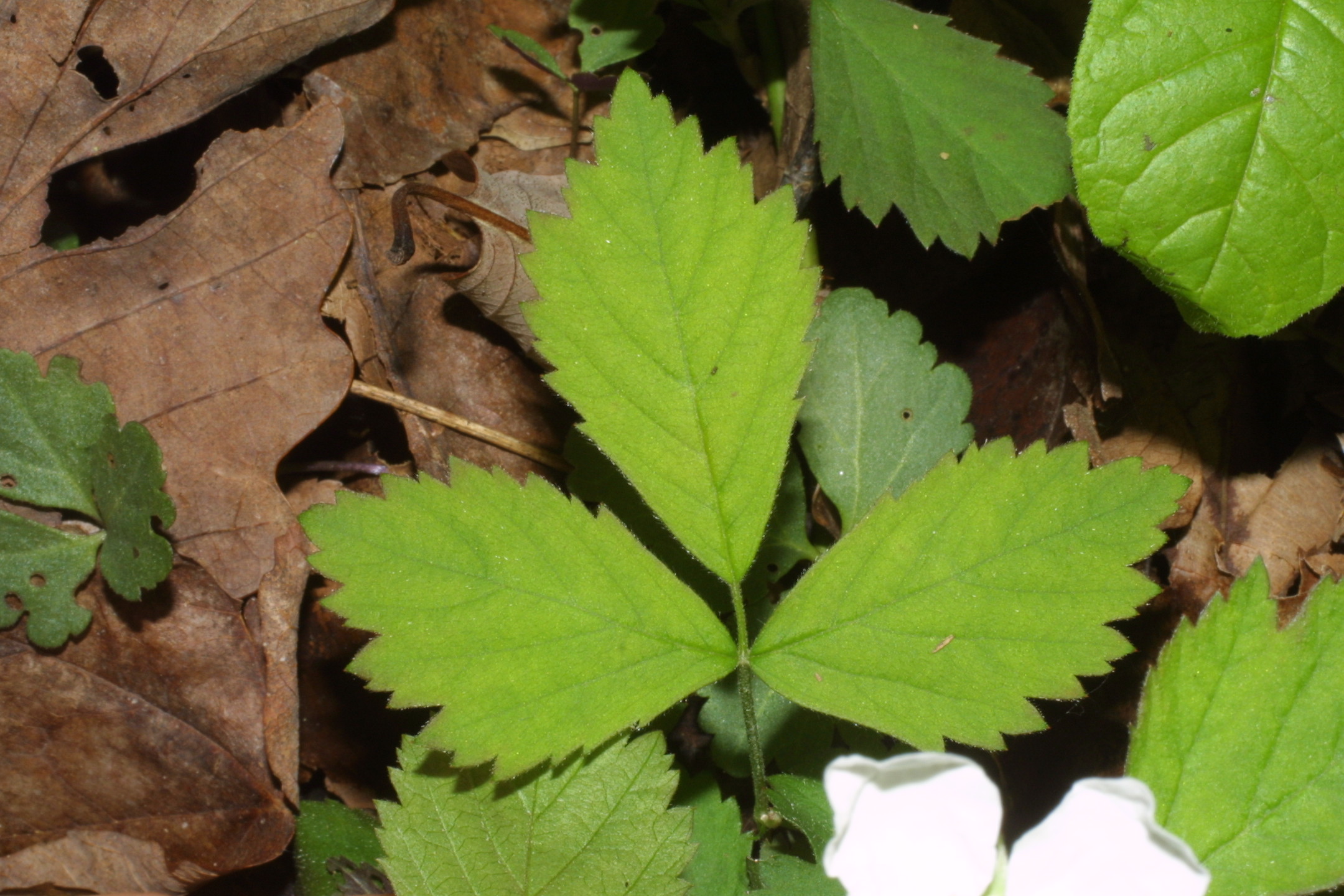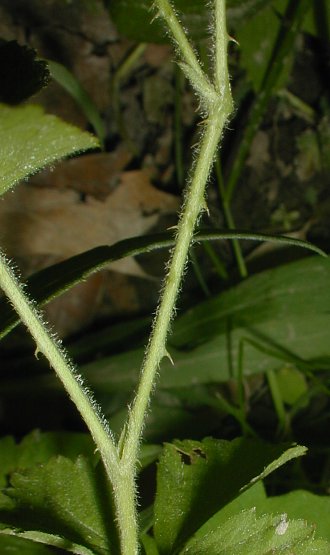 Download PDF
Download PDF
Name: Rubus flagellaris Willd
Family: Rosaceae, the Rose family
Common Names: Northern Dewberry, America Dewberry, Common Dewberry (1,4,5)
 Etymology: Rubus is Latin for “bramble,” “blackberry,” or “raspberry.” Flagellaris means “whip-like” in Latin (9).
Etymology: Rubus is Latin for “bramble,” “blackberry,” or “raspberry.” Flagellaris means “whip-like” in Latin (9).
Botanical synonyms (4, 18, 21):
Rubus baileyanus Britton
Rubus canadensis L.
Rubus geophilus Blanch.
Rubus procumbens Muhl.
Rubus rhodophyllus Rydb.
Rubus subiniflorus Rydb.
Rubus invisus (Bailey) Britton
Rubus enslenii Tratt,
Rubus leviculus Bailey
Quick Notable Features:
¬ alternate, palmately compound leaves with 3(-5) serrated leaflets
¬ 5-parted flower with white petals that are longer than the sepals
¬ fleshy, aggregate black fruit
¬ stem tips root after arching
Plant Height: R. flagellaris normally trails with stems on the ground, or initially grows erect but then develops a low arch. The stem is 2-5 m long with floricanes up to ~1.2m tall (12, 24).
Subspecies/varieties recognized (10,18):
Rubus flagellaris var. almus L.H.Bailey
Rubus flagellaris var. geophilus (Blanch.) L.H.Bailey
Rubus flagellaris var. inermis (Willd.) DC.
Rubus flagellaris var. invisus (L.H.Bailey ) L.H.Bailey
Rubus flagellaris var. michiganensis (Card.) L.H.Bailey
Rubus flagellaris var. occidualis L.H.Bailey
Rubus flagellaris var. roribaccus (L.H.Bailey) L.H.Bailey
Most Likely Confused with: other members of Rubus such as R. allegheniesis, R. argutus, R. occidentalis. It may also be confused with Rosa multiflora, also a climber (16).
Habitat Preference: R. flagellaris is naturally found in dry open habitats. It grows best in areas with full sun to part shade and where soil is dry to moist. It is mostly found in open fields, woodlands, and forest margins. It is part of the dominant vegetation of dry sand prairies in southern and western Lower Michigan (1,2,14,19).
 Geographic Distribution in Michigan: R. flagellaris exists south of, and including, the counties at the latitude of Bay County except: Branch, Jackson, Eaton, Ionia, Saginaw, Tuscola, Sanilac, Lapeer, Midland, and Isabella. In other parts of the Lower Peninsula, it is found in the following counties: Clare, Lake, Kalkaska, Mason, Wexford, Roscommon, Oscoda, Crawford, Grand Traverse, Benzie, Leelanau, Antrim, Emmet, Cheboygan, and Beaver Island. In the Upper Peninsula, it is found in Alger, Baraga, Dickinson Houghton, Keweenaw, Marquette, Menominee, and Ontonagon Counties (1,26).
Geographic Distribution in Michigan: R. flagellaris exists south of, and including, the counties at the latitude of Bay County except: Branch, Jackson, Eaton, Ionia, Saginaw, Tuscola, Sanilac, Lapeer, Midland, and Isabella. In other parts of the Lower Peninsula, it is found in the following counties: Clare, Lake, Kalkaska, Mason, Wexford, Roscommon, Oscoda, Crawford, Grand Traverse, Benzie, Leelanau, Antrim, Emmet, Cheboygan, and Beaver Island. In the Upper Peninsula, it is found in Alger, Baraga, Dickinson Houghton, Keweenaw, Marquette, Menominee, and Ontonagon Counties (1,26).
Known Elevational Distribution: The guide to Smoky Mountains (Tennessee) plants suggests this is a lower elevation species (probably below 2500 feet).
Complete Geographic Distribution: Rubus flagellaris is native to North America and Canada. It is found in all states east of Minnesota, Nebraska, Kansas, Oklahoma, and Texas. In Canada it is found in New Brunswick, Ontario, and Quebec (4,8).
Vegetative Plant Description: Rubus flagellaris is a perennial shrub whose individual canes live two years (biennial). The primocanes (first year) are usually erect at first, and later become low-arched and trail along the ground. There are scattered hooked prickles along the stem, and rooting usually occurs at the tips. Old stems are brown and woody, while young stems are green and more or less hairy (see image of young stem). The fruits and flowers can appear on primocanes but are largely restricted to the floricanes (second year), which then senesce after this second season of growth and reproduction.
The leaves are alternate and palmately compound. Most portions of the primocanes have three leaflets, although there can be five leaflets. The floricanes generally have three leaflets. The leaflets are ovate to lance-elliptical. They are usually 2-7 cm long and 0.5-6 cm wide. The leaflets are serrated and mostly hairless. Each leaflet is pale green on the underside (not white). The terminal leaflet has a short petiole, while the lateral leaflets are sessile. Each compound leaf is connected to the stem by a long petiole (3,5,17,22,24).
 Climbing Mechanism: R. flagellaris is a scrambler that climbs weakly using recurved prickles (R. J. Burnham, pers. obs.).
Climbing Mechanism: R. flagellaris is a scrambler that climbs weakly using recurved prickles (R. J. Burnham, pers. obs.).
Flower Description: The flower of R. flagellaris is 5-parted with both male and female organs (perfect). The inflorescence is a terminal corymb of 2-9 flowers characterized as flat-topped or elongated and subtended by bracts that are longer than wide. The pedicels are pubescent. Each flower is about 2.5cm broad with sepals 0.5-0.8 cm long and the wrinkled-looking petals 1.5-3 cm long. The petals are white or rarely pink and obovate. Each flower consists of numerous stamens that surround a green cluster of loosely adherent carpels (3,24,27).
Flowering Time: In Wisconsin and North Carolina, Rubus flagellaris blooms in May-June (5,20).
Pollinator: Rubus flagellaris is pollinated by insects, and is known to attract a variety of bees. The plant can also reproduce by seeds formed without sexual fusion (13,14,24).
 Fruit Type and Description: The globose to short oblong fruit is an aggregation of druplets, each of which has an outer fleshy layer surrounding the endocarp. The drupelets are red, maturing to black. The fruit is 1-2.5 cm long and wide. It is juicy and sweet (2,3,12).
Fruit Type and Description: The globose to short oblong fruit is an aggregation of druplets, each of which has an outer fleshy layer surrounding the endocarp. The drupelets are red, maturing to black. The fruit is 1-2.5 cm long and wide. It is juicy and sweet (2,3,12).
Seed Description: Each drupe has one “hard- pitted” seed with almost no endosperm, a feature common to the genus Rubus. In the literature, Rubus flagellaris’s seeds are referred to as “stones.” They are described as 0.3-0.34 cm long, yellowish, and strongly areolate (3,23).
Dispersal Syndrome: The seeds of R. flagellaris are dispersed mainly by birds and other animals. The aggregate fruit is eaten by mammals (non-bat) and birds (15,23).
Distinguished by: Rubus flagellaris is distinguished from other Rubus species by aspects of the leaf, fruit, and flower. R. allegheniesis most often has five leaflets/leaf, compared to R. flagellaris, which most often has three leaflets/leaf. The cane tips of R. allegheniesis and R. argutus do not root, while they do root in R. flagellaris. R. argutus has leaflets that are more lanceloate and elliptical in shape as opposed to obovate in R. flagellaris. Rubus occidentalis is distinguished from R. flagellaris by sepals that are longer than petals, leaflets with white undersides, and a raspberry fruit. Rosa multiflora appears similar to Rubus flagellaris vegetatively, but can be distinguished by the leaves with 7-9 pinnately arranged leaflets (versus 3-5). The fruit of R. multiflora fruit is a “hip”, which is small, smooth, and red (16).
Other members of the family in Michigan (number species): Rubus (48), Agrimony (5), Amelanchier (6), Argentina (1), Aruncus (1), Chamaerhodos (1), Comarum (1), Crataegus (42), Dalibarda (1), Dasiphorda (1), Duchesnea (1), Filipendula (1), Fragaria (2), Geum (9), Gillenia (2), Malus (4), Photinia (2), Physocarpus (2), Potentilla (11), Prunus (16), Pyrus (1), Rosa (18), Sanguisorba (3), Sibbaldiopsis (1), Sorbaria (1), Sorbus (3), Spiraea (6), Waldsteinia (1) (source 8).
Ethnobotanical Uses: Native Cherokee use R. flagellaris for drugs and food. Infusion of the root or leaf is used as a remedy for diarrhea, hemorrhoids, sore throat, or rheumatism (problems with joints and connective tissue). The fruit is also use to make juice and food. Native Osage people use the roots to make a tea that calms stomach irritation (2,11).
 Phylogenetic Information: The genus Rubus is a member of the subfamily Rosoideae in the family Rosaceae. Rosoideae is distinguished by having many carpels and stamens, and an aggregate of achenes or drupes as fruits. The family Rosaceae dates from at least 76 million years, within the order Rosales, which itself has been dated back 88-89 million years. Rosales is in the subclass Rosidae, a member of the eudicots (6,7).
Phylogenetic Information: The genus Rubus is a member of the subfamily Rosoideae in the family Rosaceae. Rosoideae is distinguished by having many carpels and stamens, and an aggregate of achenes or drupes as fruits. The family Rosaceae dates from at least 76 million years, within the order Rosales, which itself has been dated back 88-89 million years. Rosales is in the subclass Rosidae, a member of the eudicots (6,7).
Interesting Quotation or Other Interesting Factoid not inserted above:
The heptaploid Rubus flagellaris is facultatively apomictic. The species produces apomictic seeds, meaning that plant embryos can grow from egg cells without being fertilized by pollen. If “extensive detectable minisatellite variation” among different genotypes of the species exists, the minisatellite DNA can be useful in distinguishing between sexually derived offspring and apomictically derived offspring. Minisatellite analyses can be beneficial for studies about the complicated mechanisms of facultative apomixis (25).
Literature and websites used:
- Voss, E.G. 1985. Michigan Flora Part II: Dicots. Ann Arbor, Michigan, USA: Cranbrook Institute of Science.
- Oklahoma Biological Survey. http://www.biosurvey.ou.edu/shrub/rubu-fla.htm (4/1/10)
- McGregor, R.L. 1986. Flora of the Great Plains. Lawrence, Kansas, USA: The University Press of Kansas.
- http://www.ars-grin.gov/cgi-bin/npgs/html/taxon.pl?104958 (4/1/10)
- http://wisplants.uwsp.edu/scripts/detail.asp?SpCode=RUBFLA (4/1/10)
- Stevens, P.F. Angiosperm Phylogeny Website. Version 9, June 2008. http://www.mobot.org/mobot/research/apweb/
- Zomlefer, W.B. 1994. Guide to Flowering Plant Families. Chapel Hill, North Carolina, USA: The University of North Carolina.
- USDA, NRCS. 2009. The PLANTS Database (4/8/10). http://plants.usda.gov/java/profile?symbol=RUFL
- Brown, R.W. 1956. Composition of Scientific Words. Washington, D.C., USA: Smithsonian Institution Press.
- The International Plant Names Index. http://www.ipni.org/index.html
- Native American Ethnobotany Database. http://herb.umd.umich.edu/herb/search.pl (4/8/10)
- Miller, J. & Miller, K. 2005. Forest Plants of the Southeast and Their Wildlife Uses. Athens, Georgia, USA: University of Georgia Press.
- http://www.pfaf.org/database/plants.php?Rubus+flagellaris
- Sarver, M.J., ed. 2007. Delaware Native Plants for Native Bees. Dover, DE: USDA NRCS and Delaware Department of Agriculture.
- ePIC: Electronic Plant Information Centre of Royal Botanic Gardens, Kew http://epic.kew.org/
- 16) Virginia Tech- Department of Forest Resources and Environmental Conservation http://www.cnr.vt.edu/dendro/dendrology/syllabus/factsheet.cfm?ID=397
- Godfrey, R. 1988. Trees, Shrubs, and Woody Vines of Northern Florida and Adjacent Georgia and Alabama. Athens : University of Georgia Press.
- TROPICOS: Missouri Botanical Garden http://www.tropicos.org/Home.aspx
- Michigan Natural Features Inventory. Michigan State University. http://web4.msue.msu.edu/mnfi/communities/community.cfm?id=10698
- tupka, A. 1964. Trees, Shrubs, and Woody Vines of Great Smoky Mountains National Park. Knoxville, Tennessee, USA: The University of Tennessee Press.
- Radford, A.E., H.E. Ahles, & C.R. Bell. 1968. Manual of the Vascular Flora of the Carolinas. Chapel Hill, North Carolina, USA: The University of North Carolina Press.
- Bryla, D.R. & B.C. Strik 2008. Do primocanes and floricanes compete for soil water in blackberry? Acta Horticulturae 777:477-482.
- Young, J.A. and C.G. Young. 1992. Seeds of Woody Plants in North America. Portland, Oregon, USA: Dioscorides Press.
- Dr. John Hilty. Illinois Wildflowers. Copyright © 2004-2010 http://www.illinoiswildflowers.info/savanna/plants/cm_dewberry.htm
- Nybom, H., S.H. Rogstad, & B.A. Schaal 1990. Genetic variation detected by use of the M12 “DNA fingerprint” probe in Malus, Prunus, and Rubus (Rosaceae). Theor Appl Genet. 79: 153-156.
- MICHIGAN FLORA ONLINE. A.A. Reznicek, E.G. Voss, & B. S. Walters. February 2011. University of Michigan. Web. January 3, 2013. http://michiganflora.net/species.aspx?id=2556
- Fernald, M.L. 1950. Gray’s Manual of Botany,8th ed. New York: American Book Company.
Image Credits (all used with permission):
1) Flower: Baskauf, Steven J. © 2004. http://www.cas.vanderbilt.edu/bioimages/species/rufl.htm
2) Leaf: Baskauf, Steven J. © 2004. http://www.cas.vanderbilt.edu/bioimages/species/rufl.htm
3) Young stem: John Hilty. Copyright © 2004-2010 http://www.illinoiswildflowers.info/savanna/plants/cm_dewberry.htm
4) Fruit: copyright Ted Bodner, Southern Weed Science Society, Bugwood.org
5) Species distribution map, derived from the Michigan Flora Online.
Primary Authors: Andrea Friedman with edits from Robyn Burnham, John Bradtke, and Cristine V. Santanna
© Robyn J. Burnham, University of Michigan
For additional information on Michigan Plant Diversity web pages please contact Robyn J. Burnham via email: rburnham“at”umich.edu